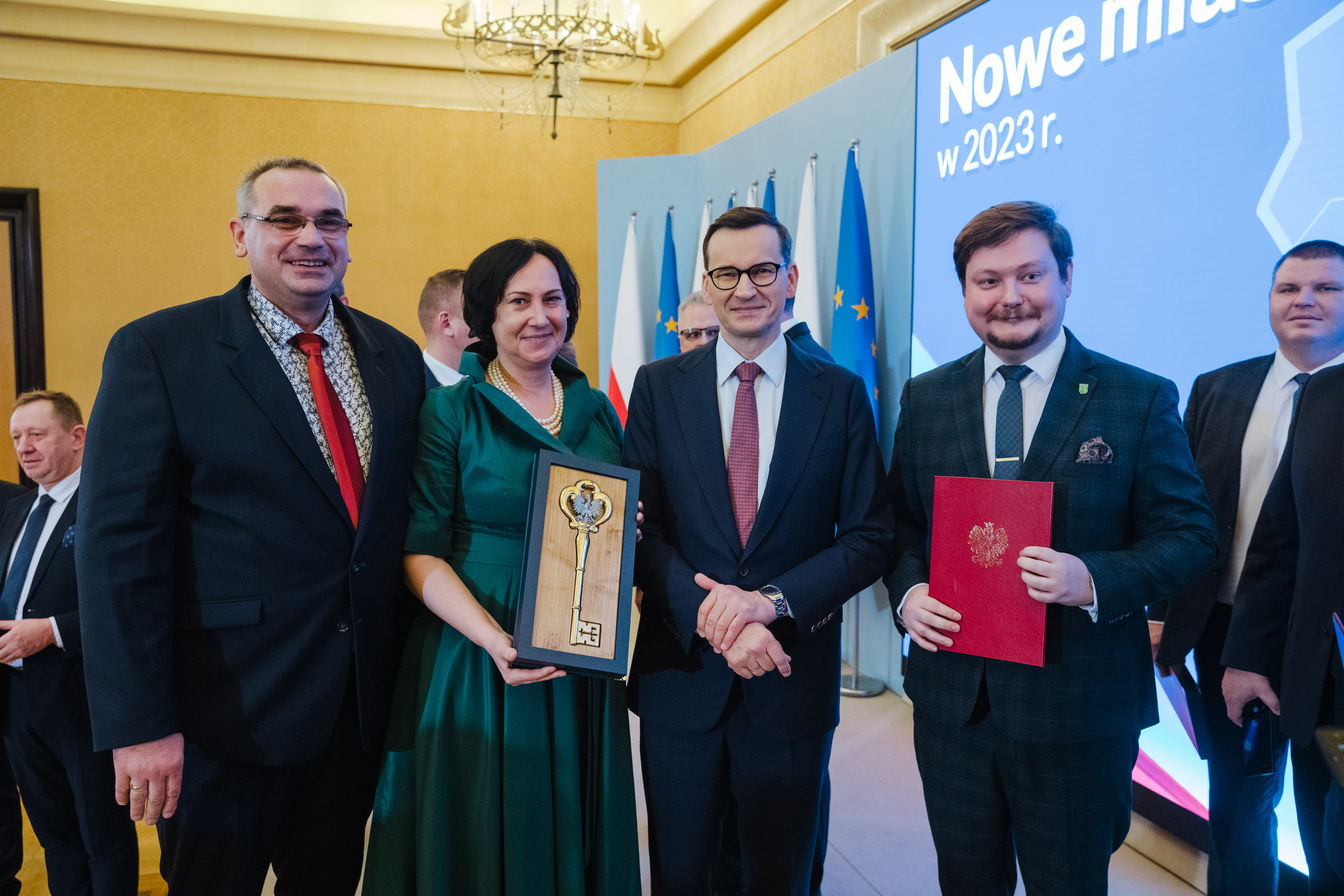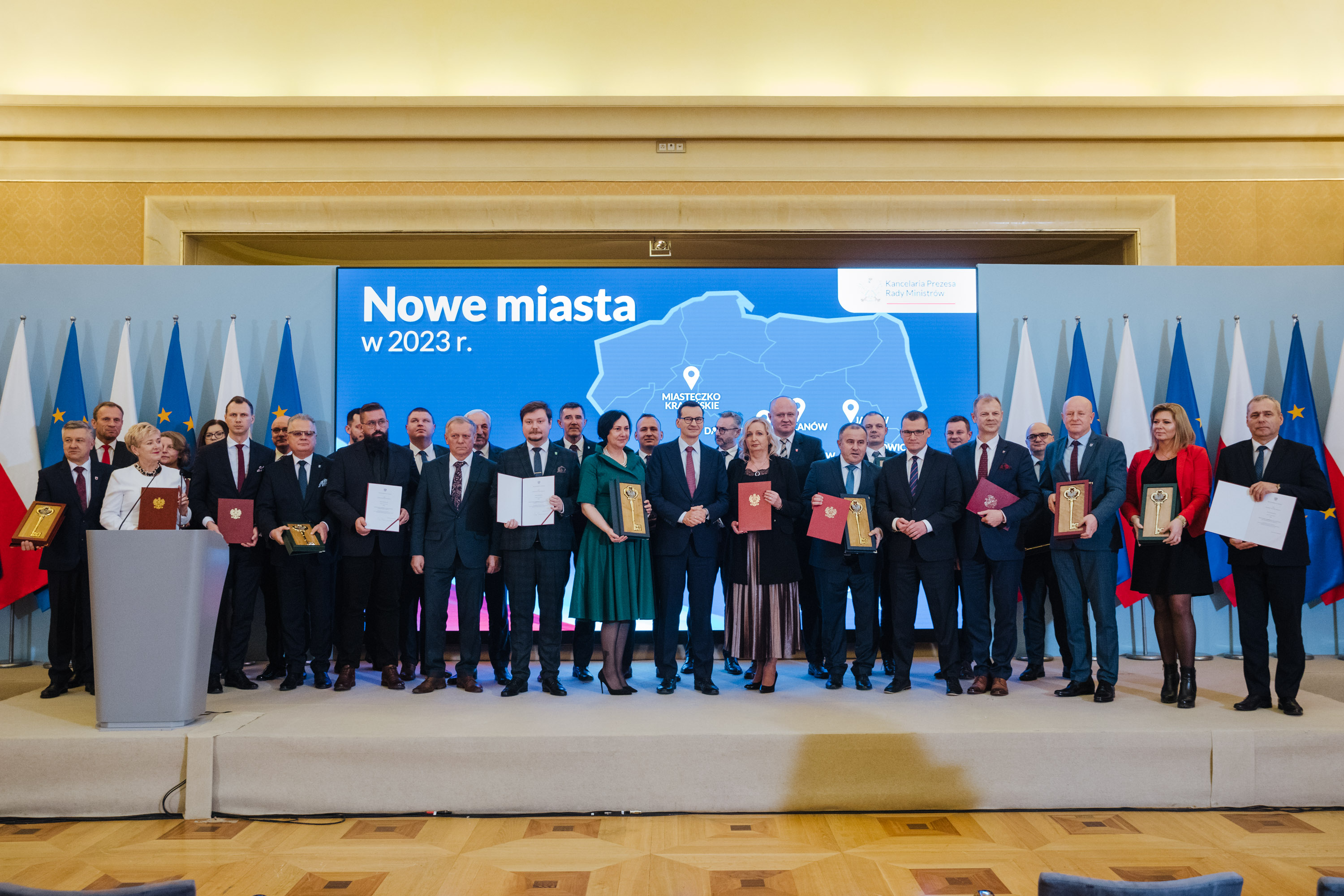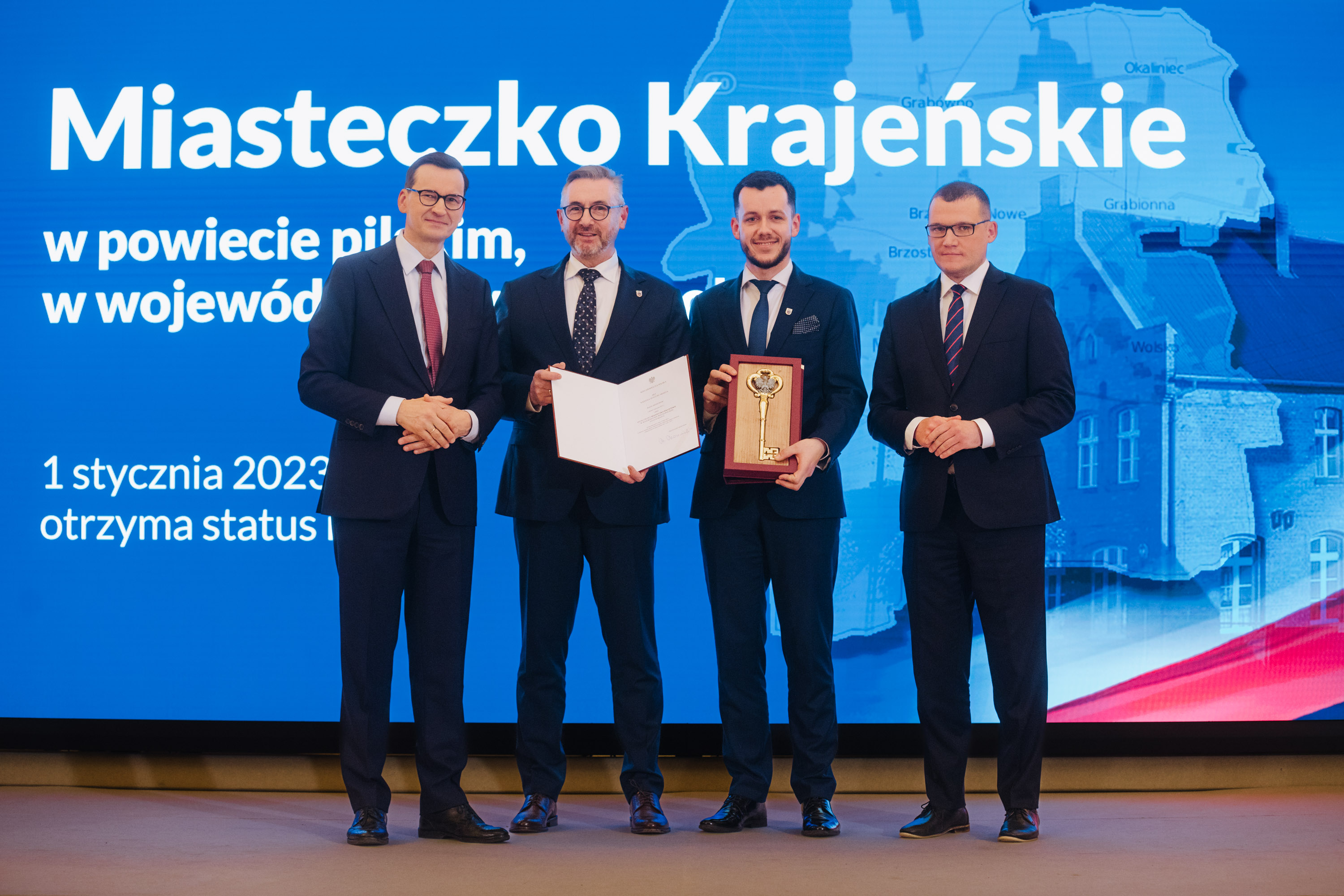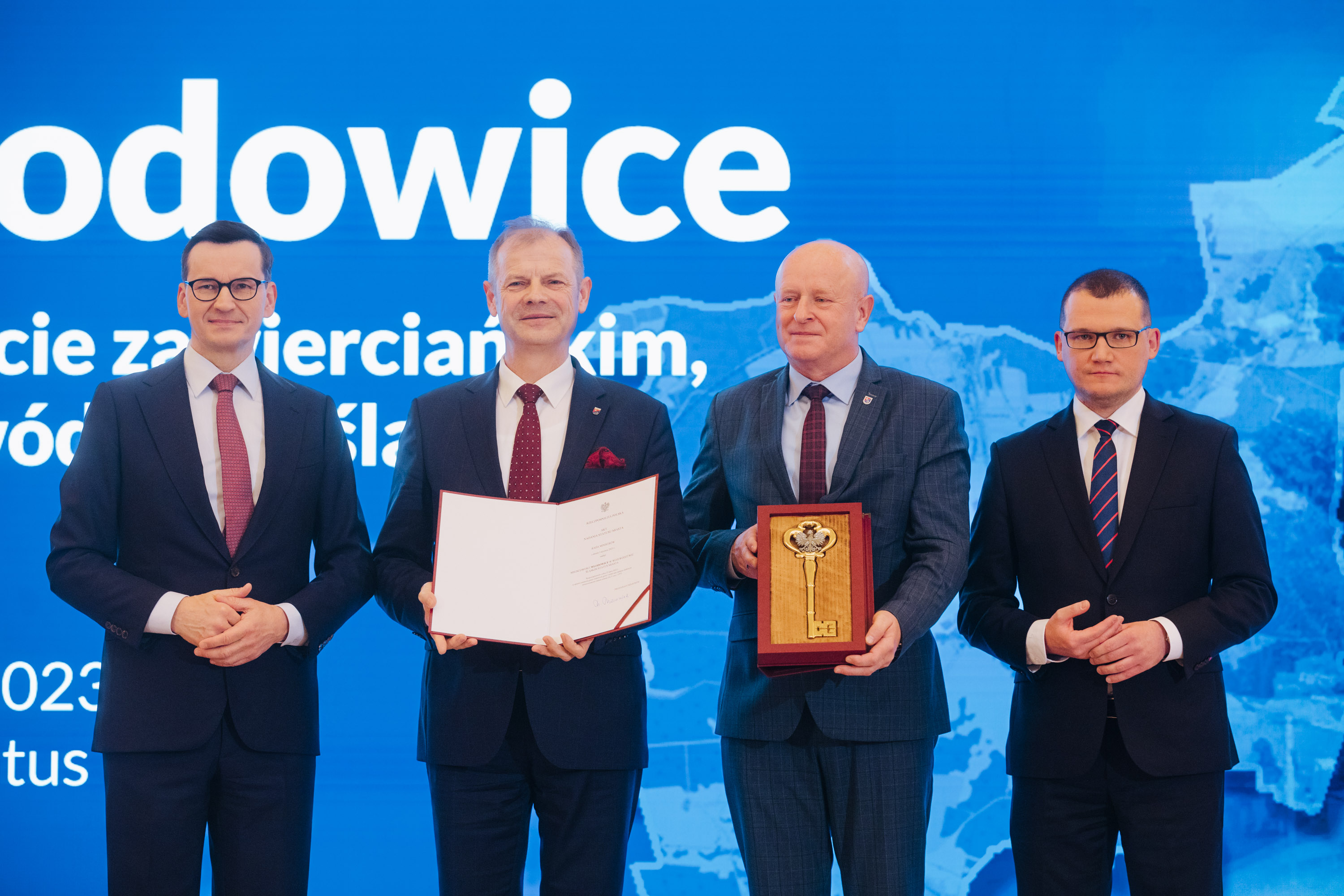15 new towns in Poland. Prime Minister Mateusz Morawiecki handed out town charters and keys to the towns
29.12.2022
As of 1 January 2023, 15 new towns will appear on the map of Poland. After the changes, there will be 979 of them. In recent years, the existing villages have raised the level of urbanisation and demonstrated an urban character. In addition, most of their inhabitants make a living from non-agricultural activities. Those locations also have good transport connections to other towns. Because of these characteristics, they have been granted town rights. Prime Minister Mateusz Morawiecki stressed that town status is a source of pride, but also a commitment to the town's development.

More towns in Poland
Prime Minister Mateusz Morawiecki noted that in most cases, the granting of town status is the restoration of town rights taken away, for example, as a result of Tsarist repressions after the January Uprising. "This was a very common practice of the tsarist regime - revenge for the participation or assistance of a town in the January Uprising," said the Head of Government. The day of 1 January 2023 shall therefore be regarded as the date when historical justice is made. Three villages did not previously have town rights: Miękinia, Łopuszno, Piekoszów.
Changes to the status of the municipalities were consulted with their residents and were supported by them in all places. The municipal authorities and the relevant province governors were also in favour of granting the town status.
Support for local governments
Prime Minister Mateusz Morawiecki stressed that new towns should attract new investors and entrepreneurs, leading to the creation of new jobs. "I firmly believe in the sustainable development of Poland, in sustainable development in all corners of Poland, in development that complements itself," emphasised the Head of Government.
It is becoming a reality, among other things, thanks to government programmes. Local governments have received a total of PLN 76.6 billion under the Government Strategic Investment Programme and the Government Local Investment Fund.
It is, inter alia, thanks to the investments implemented under government programmes that these localities have been granted municipal rights, as they have raised their urbanisation level. They have developed their communication networks, sewerage facilities, infrastructure for children and seniors, and much more.
Government programmes supporting local governments include:
- Government Strategic Investment Programme;
- Government Local Investment Fund;
- Government Road Development Fund;
- Local Government Roads Fund;
- Toddler+;
- Senior+.
List of new towns
Miękinia (Środa Śląska County, Śląskie Province) – the first records of the village date back to 1305. It has buildings listed in the provincial register of monuments. It is also known for winemaking;
Jeżów (Brzeziny County, Łódzkie Province) – was a town of the Benedictine order from 1334 to 1870, until the Order was liquidated by Prussia. Jeżów was first mentioned as early as 1138. The most important historical monument is the Benedictine monastery complex with buildings dating back the 16th-20th centuries and the monastery church of St. Andrew dating back to the 12th century;
Dąbrowice (Kutno County, Łódzkie Province) – the town was originally founded before 1455. It was degraded in 1870 by the Tsarist regime in connection with the January Uprising. The town has the Old Market Square surrounded by wooden buildings from the second half of the 19th century and a Neo-Renaissance town hall from the first half of the 19th century;
Rozprza (Piotrków Trybunalski County, Łódzkie Province) – celebrated its 950th anniversary in 2015. The village was first mentioned as early as 1065 in a document issued by Duke Bolesław the Generous. Its monuments include the 18th-century Church of the Visitation of the Blessed Virgin Mary. There are also World War II bunkers in the area;
Ujazd (Tomaszów Mazowiecki County, Łódzkie Province) – it had town rights from 1428 to 1870. The first sources mentioning the town as a knight's estate date back to 1283. The foundation charter was issued by King Władysław Jagiełło. In Ujazd, there is the Ostrowski palace with a 14-ha park dating back to 1812;
Książ Wielki (Miechów County, Małopolskie Province) – had its town rights confirmed by Queen Jadwiga in 1385. However, the foundation charter was probably obtained even before 1381. Książ Wielki was first mentioned in the records of the Cistercian monastery in 1120. Historical monuments include the Church of St Adalbert and the Church of the Holy Spirit, both from the 14th century;
Czarny Dunajec (Nowy Targ County, Małopolskie Province) – in 2016, the village was granted a statute for the Czarny Dunajec Health Resort Protection Area. For 8 years in the inter-war period (1925-1933), Czarny Dunajec was an urban municipality, but it lost those rights as a result of the change in the local government system in 1933. The village has a Jewish Cemetery from the 19th century. There is also a post-glacial peat bog called Baligówka, from which peat was extracted on an industrial scale as recently as in the mid-20th century. It is now protected under the Natura 2000 programme;
Latowicz (Mińsk Mazowiecki, Mazowieckie Province) – was granted town rights in 1423. The town was first mentioned as early as the 13th century. In its heyday, the town was the property of Polish queens, such as Bona and Anna Jagiellon. The town has two historic churches: of St Valentine and St Trinity, built at the beginning of the 20th century;
Bodzanów (Płock County, Mazowieckie Province) – it had town rights since 1351. The town is famous for its Norbertine Fair, recreated in 2005 to resemble the medieval fairs in Bodzanów organised since 1415. During the fair, there are demonstrations of, for example, folk dances and workshops of such trades as pottery;
Jastrząb (Szydłowiec County, Mazowieckie Province) – celebrated its 600th anniversary in 2022. The monuments of Jastrząb include the Church of St John the Baptist from the beginning of the 20th century and the picture of Our Lady of Sorrows, painted on a board at the turn of the 16th and 17th centuries, which can be found in the Church;
Jadów (Wołomin County, Mazowieckie Province) – had town rights in the period from 1823 to 1869. A characteristic point of Jadów is the market square, which is one of the largest in the area, the Museum of the Jadów Family, and the brick church of the Holy Cross Sanctuary dating back to 1882-1886;
Włodowice (Zawiercie County, Śląskie Province) – with the market square, which has been revitalised in recent years and has an embedded coat of arms plate, and is the main square in the municipality. The main tourist attraction of the place is the ruins of a palace built between 1669 and 1681;
Łopuszno (Kielce County, Świętokrzyskie Province) – International Painting Plein-airs have been held there for 41 years. The landmark of Łopuszno is a magnificent historical palace dating back to the turn of the 19th and 20th centuries, erected according to the design of Władysław Marconi, once the family residence of the Dobieckis – the owners of Łopuszno;
Piekoszów (Kielce County, Świętokrzyskie Province) – an important aspect is the proximity of the town to Kielce and, therefore, the concentration of buildings along national roads. Agricultural activity has virtually disappeared from the village, and the residents find employment in Piekoszów and nearby Kielce;
Miasteczko Krajeńskie (Piła County, Wielkopolskie Province) – the centre of the town is Plac Wolności square with buildings forming strings of historical architecture. The dominant architectural and height feature of the town is the Church of the Exaltation of the Holy Cross situated on a hillside, built in the years 1898-1899.









